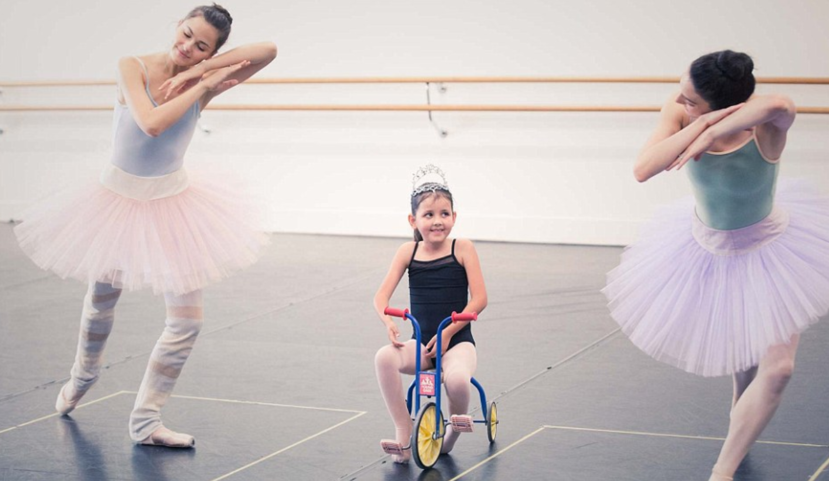Young Ballerina with Muscular Dystrophy Has Her Dream Come True

Photo: Jessica Kennedy and two ballerinas from the Australian Ballet Company. Source: Daily Mail UK/Make-A-Wish Australia.
Dreams do come true, which has been the case for Jessica Kennedy. When she was just 18 months old, Jessica was diagnosed with muscular dystrophy. Now seven, she is bound to a wheelchair with limited mobility, but this little girl is still full of dreams.
One of them is to become a ballerina and be able to dance with the Australian Ballet Company. Well, thanks to the Make-A-Wish Foundation, Jessica's dream came true on her 7th birthday.
Jessica’s big day: An unforgettable milestone
On her 7th birthday, Jessica was given the chance to dance with two ballerinas, Valerie Tereshchenko and Nicola Curry from the ballet company. The two ballerinas have taught her the ballet moves from the Princess Aurora ballet. However, that was not the only gift she received. She also received a tutu, leotard, tiara, and pink slippers, which is her favorite color. She even had a special ballerina birthday cake and invited to watch the Sugar Plum Fairy, which she and her older brother, Angus loved.
Jessica and her family were picked up and escorted to The Australian Ballet by a pink stretch limo. Upon arriving there, instead of sitting in a wheelchair, she was transferred to a tricycle so that she could move freely as she dances. They even had a pianist who played Happy Birthday as the two ballerinas and those who have accompanied her, including her brother, her parents, and volunteers from Make-A-Wish, sang to it. For her performance, Jessica also received roses.
Afterwards, she was also given the chance to have a behind-the-scenes tour of the dance studio before she left.
For Jessica’s mother, she couldn't have been more thankful for everyone who had a part in this very special day, knowing that her daughter would never forget it.
About Make-A-Wish
The organization that made all of this possible was the Make-A-Wish Australia Foundation, which is an organization that was established back in 1985. Since it was found, they were able to make more than 8,000 wishes for children (who are suffering from life-threatening diseases) come true. Through this, they want to provide these children hope and strength for them to face all of the challenges brought by their disease and, of course, joy as well from having their wishes granted. They raise money through community fundraising, business partnerships, bequests and with the help of their individual donors.
Jessica Kennedy and her battle with muscular dystrophy
Since Jessica has been diagnosed with muscular dystrophy at a very young age, she was not able to crawl. She also needed assistance whenever she wanted to get up from the floor, take a bath, and even go to the toilet. Her wheelchair has been her companion since then.
Muscular Dystrophy is a disease that makes her muscles grow weak over time, as it mainly affects the skeletal muscles, which are used for movement. Most of the people who have it experience difficulty in walking without assistance. They are also likely to develop contractures in the joints of their knees, hips, and arms, which restrict their movements.
On the other hand, some patients also suffer from weakened respiratory muscles, making it difficult for them to breathe. So, they need to use a machine-like ventilator to help them breathe. In some cases, they may even need to undergo surgery to make a hole in their throat for ventilation, but there are also now new approaches for managing the respiratory complications brought by muscular dystrophy.
The cost of having muscular dystrophy
GSK, a pharmaceutical company, supported a study that looked at the data from 770 DMD patients across the US and EU in order to determine the overall cost of the illness and its economic burden as well. The results of the study show that the estimated patients' annual cost was from around $23,920 to $54,270. This only goes to show that the direct cost of DMD is 7-16 times bigger than the per capita spending on health of US and EU. When it comes to its overall societal burden, it is estimated to be $80,000-$121,000. This number also increases as the disease progresses.
Having muscular dystrophy is quite expensive as well. In fact, a wheelchair costs around $23,000. Apart from that, a wheelchair friendly vehicle is also needed since a wheelchair cannot fit into the typical size of the car. Upgrades may also be necessary to help patients with muscular dystrophy with their mobility at home, which all costs money.
In addition to that, the more the patient ages, the more the cost increases. Since they experience more complications, they also require more visits to their doctor.
Because of how costly it is to have a family member with muscular dystrophy, Jessica’s mother, together with her friend, has hosted a fundraising event for her. She has also asked people to donate items that can be used for an auction.
More information about muscular dystrophy
MD or Muscular Dystrophy is a progressive disease. Meaning to say, its symptoms get worse over time. Its severity differs from person to person. While some have symptoms of MD during infancy and childhood, some may not appear until the patient reaches middle age. Oftentimes, it affects a particular muscle group like the heart muscles or the muscles for breathing. It can be diagnosed through a physical examination, muscle biopsy, and blood tests.
Possible complications associated with the said disease are the shortening of the muscles around the joints, scoliosis, and cardiovascular complications. Problem with swallowing is also likely to occur. So, they are likely to choke on food. There have also been cases where it led to the death of the patient. Now, when it comes to its risk factors, it can affect people of all ages, gender, and races. However, young boys have a higher risk of acquiring Duchenne muscular dystrophy, which is one of the most common forms.
People who have a family member with MD are likely to develop it as well. According to the systematic review of Leadley et al. involving 58 studies on DMD, the birth prevalence in 100,000 live births is 15.9-19.5 while the point prevalence in 100,000 males is 1.9-10.9. When it comes to the mortality, 3 studies reported that the median survival is 24-26 years.
This is the reason why people with a family history of muscular dystrophy must undergo a genetic testing to know their likelihood of developing the disease. This test will also help them identify the possibility of passing MD to their children even though they don’t have it. Also, as this helps determine the cause of MD, it would be much easier to identify the kind of treatment that would work best for them.
At present, there is still no cure for muscular dystrophy. Nevertheless, patients can do something to manage it or slow down its course. In the case of Jessica, she has been undergoing intensive physiotherapy ever since she was diagnosed with the said disease. While everyone affected by muscular dystrophy is different, it's important to see what options you have to slow the progression of the disease. While some go through physiotherapy, other patients choose to take steroids.















